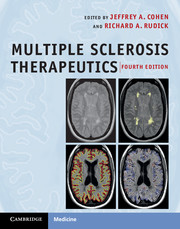21 results
Contributors
-
-
- Book:
- Translational Neuroscience
- Published online:
- 05 July 2012
- Print publication:
- 28 June 2012, pp vi-viii
-
- Chapter
- Export citation
Chapter 10 - Multiple sclerosis
-
-
- Book:
- Translational Neuroscience
- Published online:
- 05 July 2012
- Print publication:
- 28 June 2012, pp 178-196
-
- Chapter
- Export citation
23 - Multiple Sclerosis
- from Section 6
-
-
- Book:
- Clinical Trials in Neurology
- Published online:
- 05 May 2012
- Print publication:
- 12 April 2012, pp 257-272
-
- Chapter
- Export citation
Contributors
-
-
- Book:
- Clinical Trials in Neurology
- Published online:
- 05 May 2012
- Print publication:
- 12 April 2012, pp ix-xii
-
- Chapter
- Export citation
Preface
-
- Book:
- Multiple Sclerosis Therapeutics
- Published online:
- 05 December 2011
- Print publication:
- 20 October 2011, pp xvii-xviii
-
- Chapter
- Export citation
1 - Aspects of multiple sclerosis that relate to experimental therapeutics
- from Section I - Introduction
-
-
- Book:
- Multiple Sclerosis Therapeutics
- Published online:
- 05 December 2011
- Print publication:
- 20 October 2011, pp 1-11
-
- Chapter
- Export citation
Multiple Sclerosis Therapeutics - Half title page
-
- Book:
- Multiple Sclerosis Therapeutics
- Published online:
- 05 December 2011
- Print publication:
- 20 October 2011, pp i-ii
-
- Chapter
- Export citation
Multiple Sclerosis Therapeutics - Title page
-
-
- Book:
- Multiple Sclerosis Therapeutics
- Published online:
- 05 December 2011
- Print publication:
- 20 October 2011, pp iii-iii
-
- Chapter
- Export citation
Section II - Clinical trial methodology
-
- Book:
- Multiple Sclerosis Therapeutics
- Published online:
- 05 December 2011
- Print publication:
- 20 October 2011, pp 56-299
-
- Chapter
- Export citation
Contributors
-
-
- Book:
- Multiple Sclerosis Therapeutics
- Published online:
- 05 December 2011
- Print publication:
- 20 October 2011, pp viii-xii
-
- Chapter
- Export citation
Section IV - Therapy in clinical practice
-
- Book:
- Multiple Sclerosis Therapeutics
- Published online:
- 05 December 2011
- Print publication:
- 20 October 2011, pp 583-730
-
- Chapter
- Export citation

Multiple Sclerosis Therapeutics
-
- Published online:
- 05 December 2011
- Print publication:
- 20 October 2011
Abbreviations list
-
- Book:
- Multiple Sclerosis Therapeutics
- Published online:
- 05 December 2011
- Print publication:
- 20 October 2011, pp xiii-xiv
-
- Chapter
- Export citation
Plate Section
-
- Book:
- Multiple Sclerosis Therapeutics
- Published online:
- 05 December 2011
- Print publication:
- 20 October 2011, pp -
-
- Chapter
- Export citation
Section I - Introduction
-
- Book:
- Multiple Sclerosis Therapeutics
- Published online:
- 05 December 2011
- Print publication:
- 20 October 2011, pp 1-55
-
- Chapter
- Export citation
Index
-
- Book:
- Multiple Sclerosis Therapeutics
- Published online:
- 05 December 2011
- Print publication:
- 20 October 2011, pp 731-752
-
- Chapter
- Export citation
27 - Natalizumab to treat multiple sclerosis
- from Section III - Clinical trials of multiple sclerosis therapies
-
-
- Book:
- Multiple Sclerosis Therapeutics
- Published online:
- 05 December 2011
- Print publication:
- 20 October 2011, pp 330-343
-
- Chapter
- Export citation
Section III - Clinical trials of multiple sclerosis therapies
-
- Book:
- Multiple Sclerosis Therapeutics
- Published online:
- 05 December 2011
- Print publication:
- 20 October 2011, pp 300-582
-
- Chapter
- Export citation
Contents
-
- Book:
- Multiple Sclerosis Therapeutics
- Published online:
- 05 December 2011
- Print publication:
- 20 October 2011, pp v-vii
-
- Chapter
- Export citation
Copyright page
-
- Book:
- Multiple Sclerosis Therapeutics
- Published online:
- 05 December 2011
- Print publication:
- 20 October 2011, pp iv-iv
-
- Chapter
- Export citation



